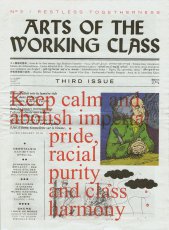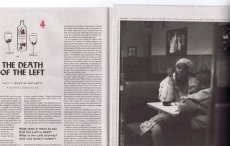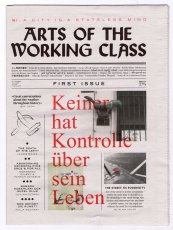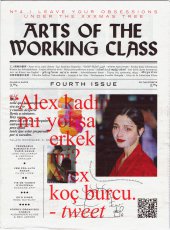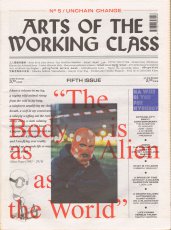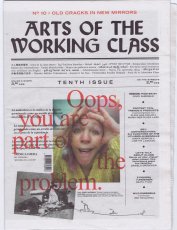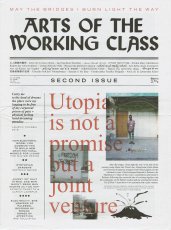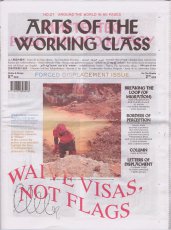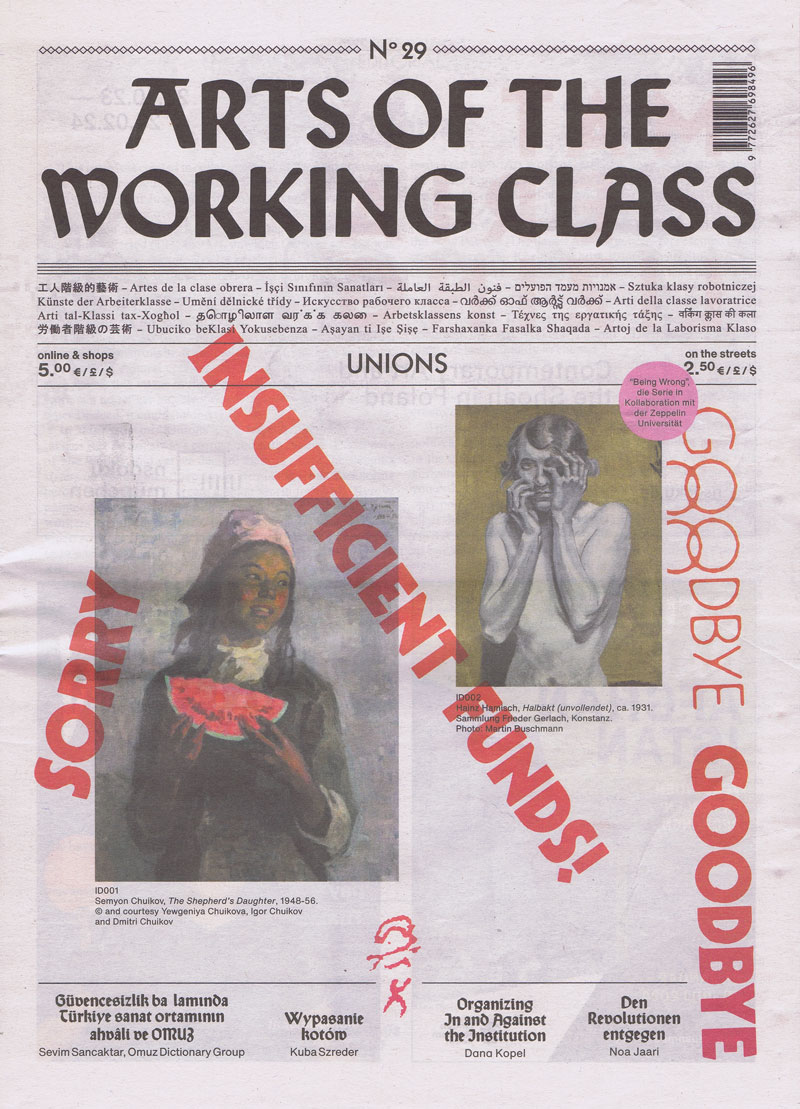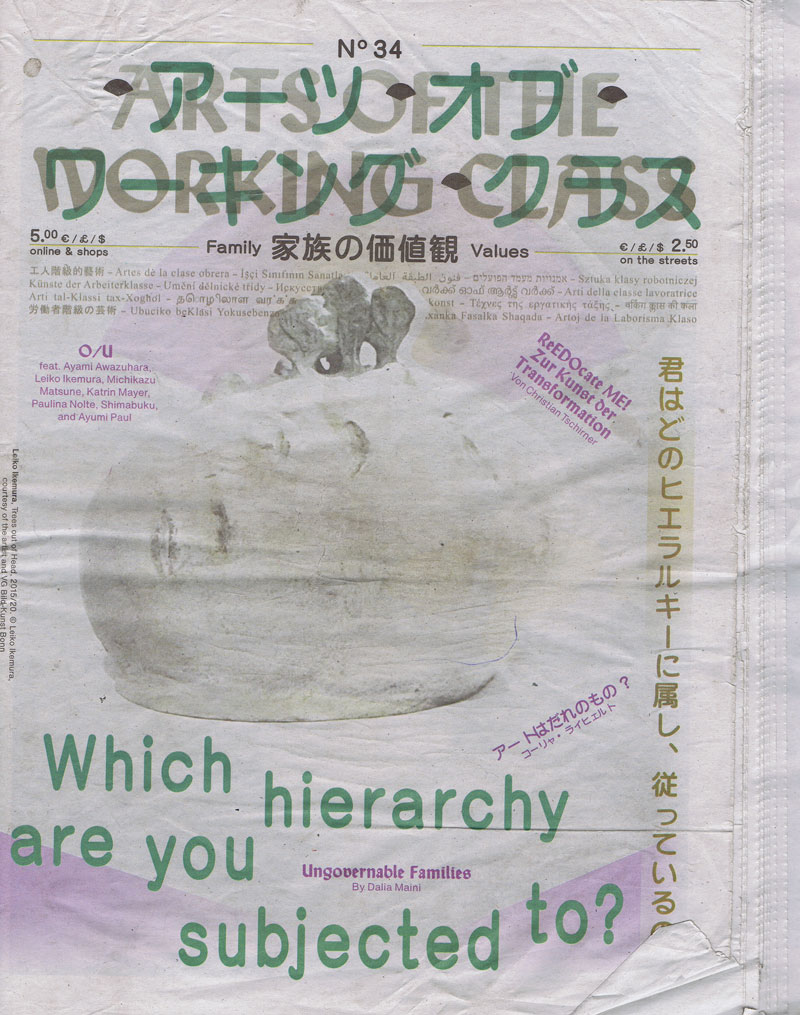|
Titel
-
Arts of the Working Class No. 07
Technische
Angaben
-
keine weiteren Angaben vorhanden
|
Titel
-
Arts of the Working Class No. 03 - Restless Togetherness
Technische
Angaben
-
48 S., 35x26 cm, Auflage: 10.000, 2 Stück. keine weiteren Angaben vorhanden
Zeitungsdruck, Blätter lose ineinander gelegt
ZusatzInfos
-
Keep calm and abolish imperial pride, racial purity and class harmony
Aus dem Booklyn-Archiv
This third issue of our newspaper is dedicated to this year’s overwhelming number of anniversaries and its abysms. With curiosity we notice their paradoxical relationship with the present. It’s been ten years since the financial crash, but monetary values are not more balanced and speculation bubbles are bigger than ever. It’s been 50 years since LSD came into popular use, opening the doors of perception, but perception seems to be even narrower today than it was back then. It’s been 80 years since Austria’s annexation to Germany, and yet ‚The Sound of Music‘ is still remembered as a classic, sweetened depiction of resistance towards fascism’s expansion in Europe, rather than the fall of aristocracy, what it really was. It’s been 100 years since the end of the First World War and yet the struggle between Conservatism and Socialism has never been so prevalent. It’s been 200 years since Marx was born, and his work still remains a historical ideal rather than a reality.
Text von er Webseite
|
Titel
-
Arts of the Working Class No. 01 - A city is a stateless mind
Technische
Angaben
-
40 S., 35,2x25,8 cm, 2 Stück. keine weiteren Angaben vorhanden
Lose ineinander gelegte Blätter, Druck auf Zeitungspapier.
ZusatzInfos
-
„Arts of the Working Class“ ist eine Straßenzeitung für Armut, Reichtum und Kunst. Sie erscheint alle zwei Monate und enthält Beiträge von Künstlern und Denkern aus verschiedenen Feldern und in verschiedenen Sprachen. Sie richtet sich an die Arbeiterklasse, also an alle, und es geht um alles, das allen gehört. Jeder, der sie verkauft, verdient mit. Jeder Künstler, dessen Arbeit beworben wird, gestaltet mit.
„Arts of the Working Class“ wird vom Künstler Paul Sochacki und der Kuratorin Maria Ines Plaza Lazo entwickelt und erscheint bei Reflektor M. Die Straßenzeitung erscheint am 26. April 2018 im Rahmen von Paul Sochackis Ausstellung „Self-reflection“. Sie wird unter anderem in der Galerie Exile und auf der Straße vertrieben. Verkäufer erhalten Kontingente zum halben Preis.
Text von der Webseite.
|
Titel
-
Arts of the Working Class No. 04 - Leave your Obsessions under the XXXMas Tree
Technische
Angaben
-
48 S., 35,2x25,8 cm, 2 Stück. keine weiteren Angaben vorhanden
Lose ineinander gelegte Blätter, Druck auf Zeitungspapier.
ZusatzInfos
-
Identität hat, wie die Kunst, viele Definitionen. In unserer vierten Ausgabe, die letzte in 2018, geht es um veraltete Identitätspolitik und die Alternativen ihrer Erneuerung. Um das Dilemma, mit oder ohne Obsessionen zu existieren, um das Gleichgewicht das man zwischen sich und den anderen zu finden sucht, und um die Frage ob mit alternativer Wissensproduktion und intimen Handlungen mit kollektivem Bewusstsein die Hegemonie des Ausdrucks, der Sprache und des Wissens zu überwinden ist.
Text von der Webseite.
|
Titel
-
Arts of the Working Class No. 05 - Unchain change
Technische
Angaben
-
56 S., 35,2x25,8 cm, 2 Stück. keine weiteren Angaben vorhanden
Lose ineinander gelegte Blätter, Druck auf Zeitungspapier.
ZusatzInfos
-
With UNCHAIN CHANGE we seek to develop awareness of presences and practices beyond the hegemonic, and this is how our body turns against the contours of its shadow that distresses the world with its opacities. The issue at hand contains academic texts, activist manifestos, Creole stories, fables of millennials, internet manuals, and once again welcomes the cacophony of styles, convictions and vibrations on which our movement is grounded. We aim, above all, to heal the abyss between art and society.
Text von der Webseite.
|
Titel
-
Arts of the Working Class No. 10 - Old Cracks in New Mirrors
Technische
Angaben
-
64 S., 35,2x25,8 cm, keine weiteren Angaben vorhanden
Lose ineinander gelegte Blätter, Druck auf Zeitungspapier.
ZusatzInfos
-
Ausgabe Februar 2020. „Arts of the Working Class“ ist eine Straßenzeitung für Armut, Reichtum und Kunst. Sie erscheint alle zwei Monate und enthält Beiträge von Künstlern und Denkern aus verschiedenen Feldern und in verschiedenen Sprachen. Sie richtet sich an die Arbeiterklasse, also an alle, und es geht um alles, das allen gehört. Jeder, der sie verkauft, verdient mit. Jeder Künstler, dessen Arbeit beworben wird, gestaltet mit.
Century-old lore holds fast to the idea that a mirror is not only a reflection but a window from the facade of appearance into one's soul. For the superstitious, breaking a mirror tempts malignant forces, soul-splintering demons and seven years of bad luck. But what of the cracks at the edges of ancient mirrors or the spider web splintering across the screen in your pocket? We have yet to devise a reflection of ourselves that can weather time or violence. For what spills forth from cracks? What use is the time you spend looking in the mirror? For the survival of our souls we need to reflect one another and cultivate solidarity. To turn away from capitalist hegemony we must abandon our reflection and turn towards the other humans, and pull each other up through the cracks.
Text von der Webseite.
|
Titel
-
Arts of the Working Class No. 02 - May the bridges I burn light the way
Technische
Angaben
-
32 S., 35,2x25,8 cm, 2 Stück. keine weiteren Angaben vorhanden
Zeitungsdruck, Blätter lose ineinander gelegt, handschriftliche Grüße beigelegt
ZusatzInfos
-
The second issue of this street newspaper attempts to glimpse what social cohesion can be; seen through contemporary art practices coming together in different texts and interventions by our contributors. Dialectical cohesion presents itself in the archives of arts in the 21st century as an accumulation of reactionary movements. The impressionists against academism, surrealists against social standards, post-modernism against modernism, content-based interpretation against formalist interpolation.
“May the bridges I burn light the way” looks at both ends of the revolutionary act: the will to reach utopias and the urge to provoke dystopia. Artists always situate themselves in history by breaking with what they believed this profession to be before becoming artists. As a title, it implies a certain pessimism; anticipating the worst outcomes of a given situation. However, it also reveals the unfortunate desire to (always) be right.
“May the bridges I burn light the way” was the title of the summer camp we organized with EXILE gallery for the collateral events of the European Biennial in Palermo, the Manifesta 12. Many of this issue’s contributors intervened in Palermo following the curatorial idea of working together with the community at the Ballarò market and the community kitchen Cre.Zi Plus. Utopia here is not a promise but a joint venture. The group of people was deliberately brought together by invitation, but the summer camp was left to the unpredictable nature of the market vendors’ routines.
Text von der Webseite
|
Titel
-
Arts of the Working Class No. 21 - Around the world in 80 pages - Forced displacement issue - Tourism issue
Technische
Angaben
-
80 S., 35,2x25,8 cm, keine weiteren Angaben vorhanden
Lose ineinander gelegte Blätter, Druck auf Zeitungspapier.
ZusatzInfos
-
AusgabeMai 2022. „Arts of the Working Class“ ist eine Straßenzeitung für Armut, Reichtum und Kunst. Sie erscheint alle zwei Monate und enthält Beiträge von Künstlern und Denkern aus verschiedenen Feldern und in verschiedenen Sprachen. Sie richtet sich an die Arbeiterklasse, also an alle, und es geht um alles, das allen gehört. Jeder, der sie verkauft, verdient mit. Jeder Künstler, dessen Arbeit beworben wird, gestaltet mit.
Anniversary launch Issue 21. Arts of the Working Class is glad to invite you on June 8 to the launch of its fourth anniversary issue AROUND THE WORLD IN 80 PAGES. Organized in collaboration with Callie’s and a.p. Starting at 6.30 PM, the event will take a tour and discuss matters of tourism and forced displacement through the words and works of its contributors. The title of both the event and our latest issue take Jules Verne’s proto sci-fi book as a starting point for our shared research. Verne, the poet and writer whose narratives took us on a journey into imaginary and inconceivable worlds, left us with an invaluable lesson– we perceive the world in its entirety only through technology, the very same technology that can only be progressive if accessible to everyone, rather than as means for individual convenience.
Text von der Webseite.
|
Titel
-
Arts of the Working Class No. 29 - Unions
Technische
Angaben
-
56 S., 35,2x25,8 cm, keine weiteren Angaben vorhanden
Lose ineinander gelegte Blätter, Druck auf Zeitungspapier.
ZusatzInfos
-
„Arts of the Working Class“ ist eine Straßenzeitung für Armut, Reichtum und Kunst. Sie erscheint alle zwei Monate und enthält Beiträge von Künstlern und Denkern aus verschiedenen Feldern und in verschiedenen Sprachen. Sie richtet sich an die Arbeiterklasse, also an alle, und es geht um alles, das allen gehört. Jeder, der sie verkauft, verdient mit. Jeder Künstler, dessen Arbeit beworben wird, gestaltet mit.Hierbei handelt es sich um die Ausgabe November 2023 die in Zusammenarbeit mit dem Kunstmuseum Stuttgart entstanden ist.
This issue was created in collaboration with the Kunstmuseum Stuttgart, in particular with Anne Vieth, who was the museum's curator until July 2023. In the context of a world whose lines of conflict are overwhelming and complex, she conceived an exhibition that looks back on the “categorization mania” of the Weimar Period (1918-1933), in which German society was searching for new coordinates for orientation. Thus, as an aide mémoire, this issue features images of this exhibition, featuring “workers” seen from the perspective of the “New Objectivity” movement, and it poses the question of which images of workers dominate our imagination today.
Englischer Text von der Webseite.
|
Titel
-
Arts of the Working Class No. 34 - Family Values
Technische
Angaben
-
56 S., 35,2x25,8 cm, keine weiteren Angaben vorhanden
Lose ineinander gelegte Blätter, Druck auf Zeitungspapier, Einlage einer Doppelseite in der Mitte der Zeitung: Berlin Global, The Berlin Exhibition at the Humboldt Forum
ZusatzInfos
-
„Arts of the Working Class“ ist eine Straßenzeitung für Armut, Reichtum und Kunst. Sie erscheint alle zwei Monate und enthält Beiträge von Künstlern und Denkern aus verschiedenen Feldern und in verschiedenen Sprachen. Sie richtet sich an die Arbeiterklasse, also an alle, und es geht um alles, das allen gehört. Jeder, der sie verkauft, verdient mit. Jeder Künstler, dessen Arbeit beworben wird, gestaltet mit.
Is our family like a tree, firmly rooted, or like a fan, unfolding in many directions? The notion of family has long been framed as a stable, secure entity. Yet today, family values are shaped by forces that generate profound insecurity— economic, ecological, and social. Drawing from Astra Taylor's insights in The Age of Insecurity, this issue exam- ines how systems designed to create security, like money and property, paradoxically deepen our anxiety and uncertainty.
As we approach the end of a year marked by wars and destabilization, we rethink the family nucleus as more than just a biological or historical unit. We explore it through artists like Ayumi Paul, Danh Vo, and Leiko Ikemura, who offer alternative visions of interconnectedness. Taylor’s argument that capitalism is an “insecurity-producing machine” applies here, as the traditional family model is manipulated by power structures to uphold inequality, creating both division and a false sense of safety.
Inspired by Japanese graphics from the Edo period (1603–1868), safeguarded at the Langen Foundation— celebrating its 20th anniversary as a family-run art collection—we explore how contemporary artists reinterpret the era’s sustainable practices of togetherness, where human and ecological bonds coexisted in both peace and crisis. Through artists like Michikazu Matsune and Ayami Awazuhara, we see how family ties, like other social structures, are fluid and shaped by their surroundings. Yet, as Taylor notes, insecurity invites solidarity. Even the privileged are not immune to financial or environmental precarity, as Joshua Citarella and Catherine Liu discussed in their conversation on the rise of the new managerial class.
As curator Sohrab Mohebbi reminds us, “Art is where we practice freedom,” and that freedom opens new possibilities for collective strength. In this light, artists like Paulina Nolte, Malte Bartsch, and Katrin Mayer explore how expanding our concept of families—and by extension, cities and societies—can offer a path toward resilience. We hope you enjoy this edition, carefully curated to introduce Arts of the Working Class in Japan first as an e-paper and now in print on the streets of Berlin and elsewhere.
Ist unsere Familie wie ein Baum, fest verwurzelt, oder wie ein Fächer, der sich in viele Richtungen entfaltet? Der Begriff der Familie wurde lange Zeit als stabile, sichere Einheit verstanden. Doch heute sind die Werte der Familie von Kräften geprägt, die zu tiefgreifender Unsicherheit führen - wirtschaftlich, ökologisch und sozial. Auf der Grundlage von Astra Taylors Erkenntnissen in The Age of Insecurity (Das Zeitalter der Unsicherheit) wird in dieser Ausgabe untersucht, wie Systeme, die Sicherheit schaffen sollen, wie Geld und Eigentum, paradoxerweise unsere Angst und Unsicherheit vertiefen.
Da wir uns dem Ende eines von Kriegen und Destabilisierung geprägten Jahres nähern, überdenken wir die Kernfamilie als mehr als nur eine biologische oder historische Einheit. Wir erforschen sie mit Hilfe von Künstlern wie Ayumi Paul, Danh Vo und Leiko Ikemura, die alternative Visionen der Zusammengehörigkeit anbieten. Taylors Argument, dass der Kapitalismus eine „Unsicherheit produzierende Maschine“ ist, trifft hier zu, da das traditionelle Familienmodell von den Machtstrukturen manipuliert wird, um Ungleichheit aufrechtzuerhalten und sowohl Spaltung als auch ein falsches Gefühl von Sicherheit zu schaffen.
Inspiriert von japanischen Grafiken aus der Edo-Periode (1603-1868), die in der Langen Foundation - die ihr 20-jähriges Bestehen als familiengeführte Kunstsammlung feiert - aufbewahrt werden, erforschen wir, wie zeitgenössische Künstler die nachhaltigen Praktiken des Miteinanders dieser Epoche, in der menschliche und ökologische Bindungen sowohl in Frieden als auch in Krisen koexistierten, neu interpretieren. Anhand von Künstlern wie Michikazu Matsune und Ayami Awazuhara sehen wir, dass Familienbande wie andere soziale Strukturen fließend sind und von ihrer Umgebung geprägt werden. Doch, wie Taylor anmerkt, lädt Unsicherheit zur Solidarität ein. Selbst die Privilegierten sind nicht immun gegen finanzielle oder umweltbedingte Prekarität, wie Joshua Citarella und Catherine Liu in ihrem Gespräch über den Aufstieg der neuen Managerklasse erörterten.
Der Kurator Sohrab Mohebbi erinnert uns daran, dass „Kunst der Ort ist, an dem wir Freiheit praktizieren“, und dass diese Freiheit neue Möglichkeiten für kollektive Stärke eröffnet. Vor diesem Hintergrund untersuchen Künstler wie Paulina Nolte, Malte Bartsch und Katrin Mayer, wie die Erweiterung unseres Konzepts von Familien - und damit auch von Städten und Gesellschaften - einen Weg zur Resilienz bieten kann. Wir wünschen Ihnen viel Spaß mit dieser Ausgabe, die sorgfältig kuratiert wurde, um Arts of the Working Class in Japan zunächst als E-Paper und nun in gedruckter Form auf den Straßen von Berlin und anderswo vorzustellen.
Von der Website, übersetzt mit DeepL
|

